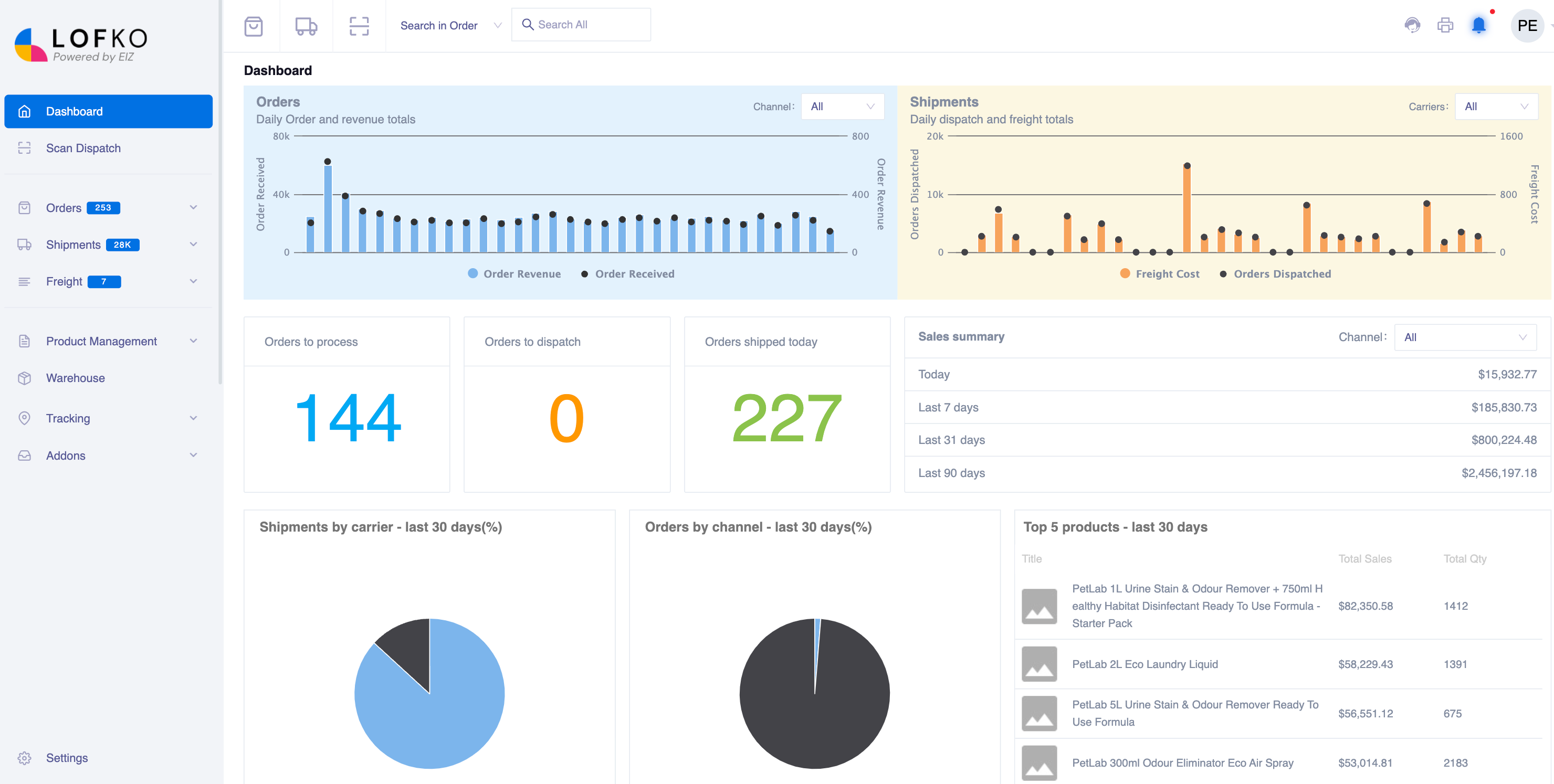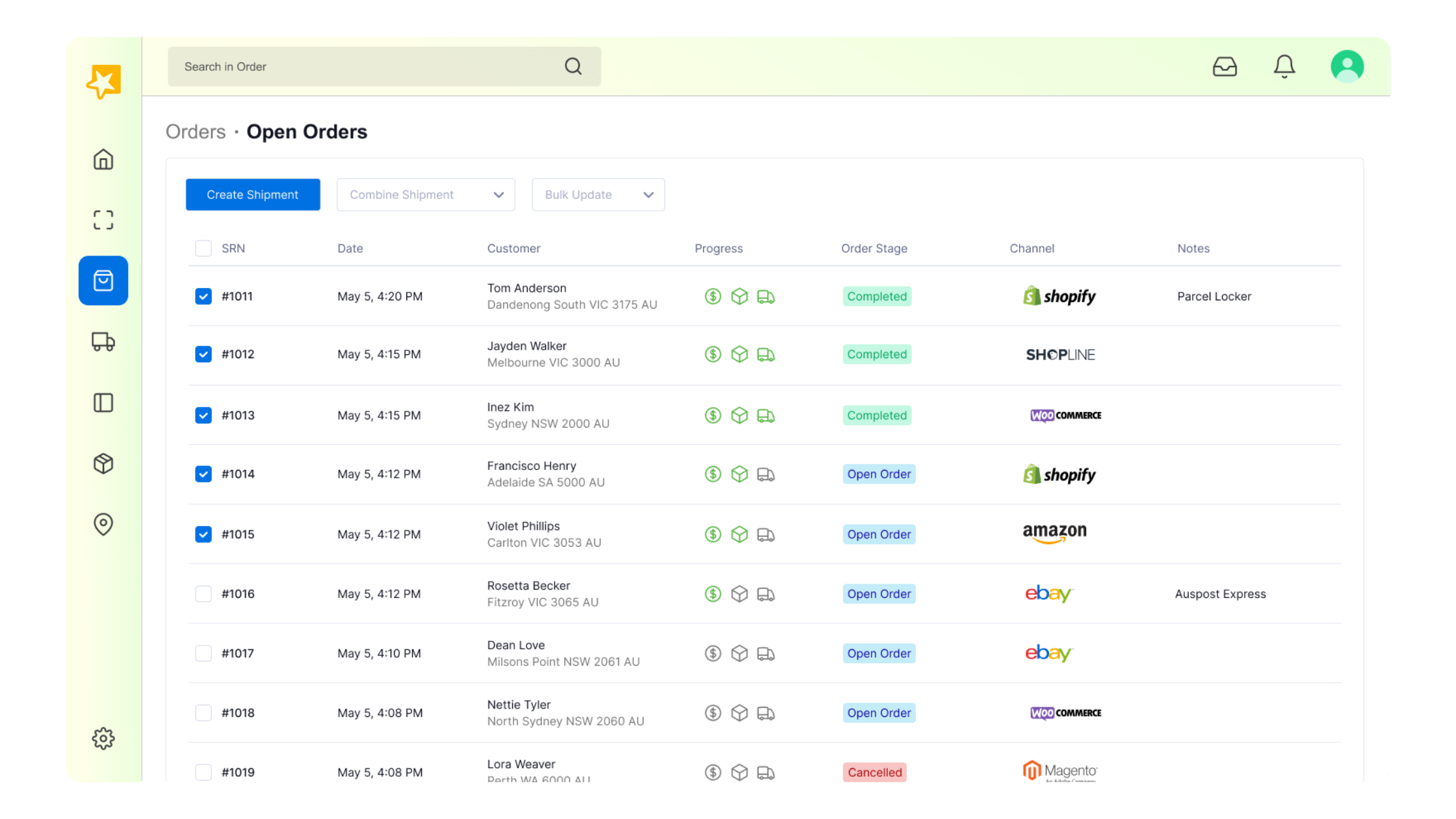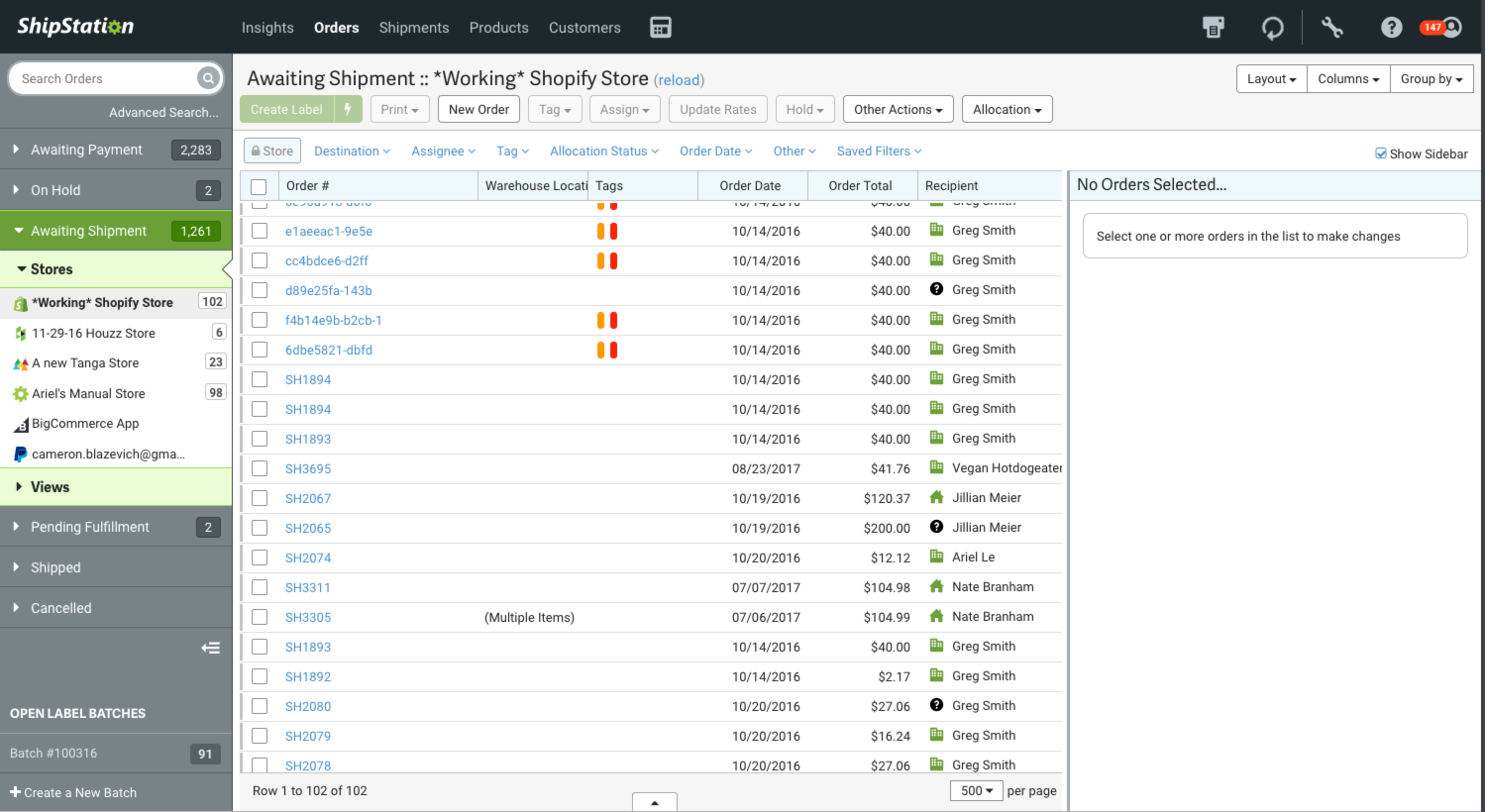Top 5 Order Management Software Solutions in Australia for 2024
30 Oct 2024
|by diadmin

Running a successful e-commerce business today means having a solid order management software system in place. As customer expectations keep rising and orders start coming in from different channels, things can get overwhelmingly fast. That’s why having the right tools to manage your orders and shipping is key to keeping your business running smoothly and your customers happy.
In this guide, we’ll walk you through the top order management software options available. We’ll cover what they do, how they can help your business grow, and what makes each one stand out. Whether you’re just getting started with your e-commerce store or looking to scale, these solutions will help you stay organized and meet customer demands, no matter how quickly your business grows.
What is Order Management Software?
Order management software is a tool that automates the order process, from receiving customer orders to fulfilling orders. It often integrates with customer relationship management systems to enhance customer interactions and streamline operations, playing a vital role in reducing human errors and improving customer satisfaction by streamlining the entire order fulfilment process. In 2024, choosing the right order management solution is more important than ever, as it can significantly impact your e-commerce store’s efficiency and profitability.
Definition of Order Management
Order management refers to the comprehensive process of managing and fulfilling customer orders from the moment they are received until the final delivery of the product. This process encompasses several critical steps, including order capture, order processing, inventory management, order fulfilment, and returns management. Effective order management is essential for ensuring customer contentment, reducing errors, and enhancing operational efficiency. By streamlining these processes, businesses can better manage customer orders, maintain optimal inventory levels, and deliver products accurately and on time.
Importance of Order Management in Business
Order management is a cornerstone of any successful business, directly influencing customer satisfaction, revenue, and overall profitability. A well-executed order management process can significantly enhance customer contentment by ensuring timely and accurate delivery of products. This, in turn, reduces errors and returns, leading to substantial cost savings. Additionally, automating manual processes and streamlining workflows can increase operational efficiency, giving businesses greater visibility and control over inventory, shipping, and fulfilment. As businesses grow, a robust order management system can scale to meet increasing demand, supporting sustained growth and success.
Key Challenges for E-commerce Startups
- Choosing the Right System
Startups often find it hard to pick the best order management system (OMS) with so many options available. - High Implementation Costs
The setup costs, including software fees, training, and integrations, can be a financial strain for new businesses. - Complex Setup & Integration
Integrating an OMS with existing tools like payment gateways and shipping carriers can be technically challenging without expert help. - Scaling with Growth
Sudden increases in order volume can overwhelm a startup without a scalable system, leading to delays and errors. - Managing Multiple Sales Channels
Startups selling on multiple platforms (e.g., websites, marketplaces) often struggle to manage orders from various sources efficiently.
The Order Management Process
Overview of the Order Management Process
The order management process is a series of coordinated steps designed to ensure that customer orders are fulfilled efficiently and effectively. This process typically includes:
- Order Capture: Receiving and processing customer orders from various sales channels, such as online marketplaces, e-commerce websites, and physical stores.
- Order Processing: Verifying and validating customer orders, checking inventory availability, and updating order status.
- Inventory Management: Managing inventory levels, tracking stock movements, and optimizing inventory allocation to meet customer demand.
- Order Fulfillment: Picking, packing, and shipping orders to customers, ensuring timely and accurate delivery.
- Returns Management: Handling returns, refunds, and exchanges, and updating inventory levels accordingly.
Key Steps in the Order Management
- Order Receipt: Orders are received from multiple sales channels, including online marketplaces, e-commerce websites, and physical stores. This step involves capturing all necessary customer information and order details.
- Order Validation: Customer orders are verified for accuracy, inventory availability is checked, and order status is updated. This step ensures that orders can be fulfilled without delays or errors.
- Inventory Allocation: Inventory is allocated to fulfil customer orders, considering factors such as inventory levels, shipping locations, and delivery times. This step optimizes inventory usage and ensures timely fulfillment.
- Order Fulfillment: Orders are picked, packed, and shipped to customers using various shipping options and carriers. This step focuses on ensuring that orders are delivered accurately and on time.
- Returns Management: Returns, refunds, and exchanges are handled efficiently, and inventory levels are updated accordingly. This step helps maintain customer satisfaction and accurate inventory records.
Challenges in the Order Management Process
- Managing Multiple Sales Channels: Handling orders from various sales channels, such as online marketplaces, e-commerce websites, and physical stores, can be complex and time-consuming.
- Inventory Management: Maintaining optimal inventory levels, tracking stock movements, and optimizing inventory allocation are critical to meeting customer demand and reducing stockouts or overstock situations.
- Manual Processes: Automating manual processes, such as order entry, inventory management, and shipping, is essential to reduce errors and improve efficiency.
- Customer Expectations: Meeting customer expectations for fast and accurate delivery, and providing timely updates on order status, is crucial for maintaining customer satisfaction.
- Scalability: As businesses grow, scaling order management processes to meet increasing demand without compromising efficiency or customer contentment is a significant challenge.
By addressing these challenges and implementing a robust order management system, businesses can streamline their operations, enhance customer satisfaction, and support sustainable growth.
Criteria for Choosing the Best Order Management Software
Before diving into the list, it’s crucial to understand what to prioritize in an OMS:
- Automation and Workflow Efficiency: Streamlining processes reduces manual work, saving time and minimizing errors.
- Scalability: Choose software that can expand alongside your business as order volumes grow.
- Integration Capabilities: An ideal OMS should seamlessly integrate with current e-commerce platforms and marketplaces like Shopify, Amazon, and WordPress.
- User-Friendly Interface: An intuitive interface accelerates onboarding and boosts productivity.
- Reporting and Analytics: Real-time data and analytics provide insights for informed decision-making.
- Customer Support and Onboarding: Dependable support ensures a smooth transition and ongoing success.
Top 5 Order Management Software Solutions for 2024

1. ShipMarvel
ShipMarvel is a cloud-based shipping and order management software designed to simplify order fulfilment and tracking for small to medium-sized e-commerce businesses. It offers seamless integration with multiple sales channels, making it easy to manage customer orders from one platform.
- Key Features:
- Multi-channel order management
- Automated shipping label generation
- Real-time order tracking
- Integration with major carriers
- Customizable shipping rules
- Pros:
- Easy to use with a user-friendly interface
- Real-time tracking improves customer communication
- Supports multiple carriers and shipping methods
- Cons:
- Limited integrations with certain third-party apps
- May lack some advanced features for larger businesses
- Pricing:
- ShipMarvel is a free software and give you all its functionality included.
- Best For:
- Small to medium-sized e-commerce businesses looking for an affordable and easy-to-use shipping solution.

2. Shippit
Shippit is a shipping platform that focuses on simplifying the fulfilment process by offering intelligent shipping options and real-time tracking. It’s built for both e-commerce stores and retail businesses that need fast and reliable shipping.
- Key Features:
- Carrier comparison and selection
- Real-time delivery tracking for customers
- Automatic tracking updates via SMS and email
- Integration with major e-commerce platforms like Shopify and WooCommerce
- Returns management features
- Pros:
- Wide range of carrier options to choose from
- Seamless integration with popular e-commerce platforms
- Excellent customer communication tools with real-time tracking updates
- Cons:
- May have higher costs for smaller businesses
- Some users report slower customer service response times
- Pricing:
- Starts at $29 per month, with pricing based on the number of orders and additional features required.
- Best For:
- E-commerce businesses that need flexible carrier options and strong customer communication tools.

3. Starshipit
Starshipit is a shipping and order management platform aimed at automating shipping tasks for e-commerce stores. It integrates with multiple sales channels and shipping carriers, offering a complete solution for order fulfilment and tracking.
- Key Features:
- Automated shipping label printing
- Integration with major e-commerce platforms and carriers
- Customizable shipping rules and workflows
- Branded tracking pages for customers
- Automated return management
- Pros:
- Highly customizable workflows
- Easy integration with e-commerce platforms like Shopify, Magento, and WooCommerce
- Strong automation features, saving time on repetitive tasks
- Cons:
- Higher pricing plans may not be ideal for smaller businesses
- Limited reporting and analytics features
- Pricing:
- Pricing starts at $25 per month for small businesses, with higher-tier plans for advanced features.
- Best For:
- E-commerce businesses with high order volumes need an automated solution to streamline their shipping and return processes.

4. ShipStation
ShipStation is one of the most popular shipping platforms for e-commerce businesses, offering a wide range of features to help automate the shipping process. It integrates with multiple marketplaces, carriers, and e-commerce platforms, providing a one-stop solution for shipping management.
- Key Features:
- Multi-channel order management and shipping
- Integration with all major carriers and platforms
- Customizable packing slips and shipping labels
- Automated shipping rules
- Batch order processing and label printing
- Integration with warehouse management systems to enhance efficiency and streamline inventory processes
- Pros:
- Extensive integration options with e-commerce platforms and carriers
- Easy-to-use dashboard for managing large volumes of orders
- Flexible and scalable to suit businesses of all sizes
- Cons:
- Can be expensive for small businesses with low order volumes
- Some users report occasional slow loading times
- Pricing:
- Plans start at $9 per month for smaller businesses, with premium plans available based on shipping volume and features.
- Best For:
- Businesses of all sizes, especially those that ship large volumes need a flexible, scalable solution.
5. Easyship
Easyship is an all-in-one shipping platform that helps businesses manage their international and domestic shipping needs. It provides access to multiple couriers, enabling businesses to offer cost-effective and fast shipping options to customers worldwide.
- Key Features:
- Global shipping options with discounted rates
- Integration with major e-commerce platforms
- Real-time tax and duty calculation for international shipping
- Branded tracking and customer communication tools
- Shipping analytics and performance tracking
- Pros:
- Excellent for businesses looking to expand internationally
- Access to discounted shipping rates with major carriers
- Strong focus on transparency with real-time cost and tax calculation
- Cons:
- May be overwhelming for small businesses without international shipping needs
- Customer support can be slower during peak times
- Pricing:
- Free plan available with pay-as-you-go shipping. Paid plans start at $29 per month for additional features and support.
- Best For:
- E-commerce businesses focused on international shipping or those looking to reduce shipping costs with carrier discounts.
Comparison Table: Top 10 Order Management Software Solutions
| Software Name | Overview | Key Features | Price | Order Limits | Best For |
|---|---|---|---|---|---|
| ShipMarvel | Cloud-based tool for small to medium businesses. | Multi-channel, automated labels, tracking | Free | No limit | Small to medium-sized businesses |
| Shippit | Shipping platform for e-commerce and retail. | Carrier comparison, real-time tracking, automation | Free | 1000 orders | E-commerce businesses needing flexible shipping |
| Starshipit | Automated platform with multi-channel support. | Automated labels, returns, customizable workflows | $40 | 250 orders | Businesses with higher order volumes |
| ShipStation | Popular shipping platform with carrier integration. | Batch processing, multi-channel support, labels | $25 USD | 500 orders | Businesses of all sizes, especially larger ones |
| Easyship | All-in-one platform for global shipping. | Global shipping, tax/duty calculation, branded tracking | $49 | 250 orders | E-commerce businesses with international shipping |
How to Choose the Right Order Management Software for Your Business
Choosing the right order management system (OMS) is crucial for streamlining your business operations and ensuring smooth transactions. To make an informed decision, consider the following factors:
Business Needs
Begin by thoroughly assessing your company’s specific requirements. Consider your business size, industry-specific needs, and the current and projected order volume. Understanding these elements will help you identify an OMS that aligns with your operational demands and supports your business model effectively.
Integration Requirements
The ability of the OMS to seamlessly integrate with your existing systems is vital. Ensure that it can easily connect with your CRM, accounting software, and any other tools you currently use. This integration will facilitate data flow, reduce manual entry, and improve overall efficiency.
Scalability
As your business grows, so will your needs. Choose an OMS that can scale alongside your business, accommodating increased order volumes and new sales channels. Look for a flexible system that can adapt to changes, ensuring it remains a valuable asset as your business evolves.
Budget
While selecting an OMS, it’s important to find a balance between cost and functionality. Determine your budget and look for software that provides the essential features you need without exceeding your financial limits. Remember that investing in a capable OMS can lead to long-term savings through improved efficiency.
By carefully considering these factors, you can select an order management system that not only meets your current needs but also supports your business’s future growth and success.
Benefits of Implementing an Order Management System
- Streamlined Order Processing: An OMS automates and refines the entire order process, from receiving online orders to packing and shipping, thereby reducing manual labour and enhancing efficiency.
- Minimized Fulfillment Errors: By automating the order flow, an OMS ensures precise and timely fulfilment, reducing common errors such as incorrect shipments or delays, and thereby boosting customer satisfaction.
- Real-Time Order Tracking: E-commerce businesses can monitor their orders in real time, providing customers with up-to-date information and giving businesses greater visibility into their operations.
- Enhanced Customer Service: With real-time updates and faster, more accurate deliveries, an OMS enables businesses to provide superior service by keeping customers informed and consistently meeting their expectations.
- Data-Driven Decision Making: An OMS provides valuable insights into order trends, customer preferences, and sales channels, empowering e-commerce businesses to make smarter, data-informed decisions for future optimization.
- Improved Multichannel Sales Management: It integrates orders from various sales channels (e.g., websites, marketplaces, social media) into a single platform, simplifying customer order management and ensuring a consistent fulfilment process across channels.
Conclusion
Order management software is essential for any e-commerce business looking to thrive in 2024. With the right order management solution, you can streamline your operations, enhance customer satisfaction, and drive growth. Explore demo versions, free trials, or consultations for the software listed to find the perfect fit for your business. For further insights, check out our related article on “How to Implement an Order Management System.”
FAQs
- What is the best order management software for small businesses?
- Zoho Inventory and ShipStation are excellent choices for small businesses due to their affordability and ease of use.
- How do I choose the right OMS for my e-commerce store?
- Consider your business size, industry-specific needs, integration requirements, and budget when selecting an OMS.
- Can OMS software integrate with my existing CRM or accounting system?
- Most order management systems offer integration capabilities with popular CRM and accounting software, such as QuickBooks and Salesforce.
- What is the average cost of order management software?
- Costs vary widely based on features and scalability; prices range from as low as $9/month to custom enterprise pricing.